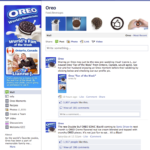During The CMO Club Summit in NYC last week, Eva Press, Director, OREO joined several panelists to discuss “Engagement in the Digital Age.” After the panel, I caught up with Eva. Here’s the resulting Q&A:
DN: You and Frank Eliason of Citi seemed to be coming from opposite ends of the spectrum when it comes to using partners to help manage social media engagement. Can you speak to the advantages of working with outside partners like your digital/social media agency?
For Oreo, our agencies are truly our partners and extensions of the brand team. We work very carefully to make sure all people who work on this beloved business, whether within Kraft or an external business partner, really understand how the brand provides people with moments of childlike delight – and that spirit should be infused in everything we do. Our digital/social media agency, 360i, is expert in the social media space. So they not only must understand how to translate the essence of Oreo into language that fits on Facebook, Twitter, but they also have a broad understanding of the digital landscape. So they can keep us up to date on trends and help us discover ways to improve our ability to connect and engage with Oreo fans based on best practices and constant monitoring of the conversation around Oreo.
DN: Do you see any risks in having outside partners manage social media engagements in channels like Facebook & Twitter? And/or what have you done to mitigate those risks for Oreo?
As 360i came onboard in June, 2010, we spent a lot of time grounding the team in what Oreo stands for. And they were instrumental in helping us bring our Oreo voice to life with our global community of fans in social media. 360i leads our digital and social efforts, but they are also a key partner as we develop overall marketing plans. We work together on all tweets, Facebook posts, and other social messaging. Social media engagement is 24/7 – and being constantly engaged is even more critical with a global brand like Oreo that spans time zones across the world. You truly need a team, and we have jointly built a great social media team that is able to engage with fans in real-time. It is a team effort, and we have a tremendous amount of trust in our agency partners. That’s so important because the Oreo brand is so deeply loved and trusted.
DN: A lot of social media programs seem to be done in isolation. Can you speak to how you’ve been able to integrate social into your overall marketing initiatives and the advantages of doing so?
Today, we live in a digital world where people have access to everything a brand does. Marketers can no longer think of engaging with consumers in terms of channel or by media – whatever we say and do is seen by everyone. That actually creates a huge opportunity. Social media can help amplify the programs we are doing in other places – to make sure that an Oreo fan who may not be watching the TV show where we ran our ad has a chance to see the ad, comment on it, and share it with his or her friends. We can ensure the most loyal Oreo fans know about new products, have a chance to enter promotions, and that we’re providing fun games and social currency like our Fan of the Week program. But it only works if all of the people on the brand team and all of the agency partners recognize the value of truly integrated marketing, working together to translate ideas from traditional advertising to digital advertising to PR, to create something that is bigger than the sum of its parts.
DN: How are you measuring the success of your social media activities for Oreos?
Measurement is essential. Certainly we’re always working to understand how social media can drive business growth – and we are starting to see an impact on our business results. But it’s also critical to see how meaningfully we are engaging with our fans because Oreo is so deeply loved.
In terms of measures, we look at our social media in terms of the numbers of people who follow the brand on Twitter and “like” the brand on Facebook. But we are also looking at the engagement of those fans: how many people retweet what the brand says; how many people like or comment on a Facebook post?
Q: You mentioned the challenges of digital coupon distribution via social channels and how they can backfire into bad WOM if/when retailers don’t accept them and/or consumers can’t print them. Assuming this means you won’t be offering coupons in the future, do you see social being able to drive retail traffic or will you think of it more as a retention channel?
We are always looking to provide value to our fans, and coupons – digital or otherwise – are certainly part of our consideration set when planning. That’s true for Oreo, and Kraft Foods more broadly. But in social media, it’s important to understand your fans and take a thoughtful approach to what is meaningful to them in the context of your community. With Oreo, we have seen that our fans have responded very positively when we provide information about new products, spark conversation about the moments of childlike delight Oreo brings, or celebrate fan generated content. We feel that builds advocacy for our brand, and contributes to our business success.
